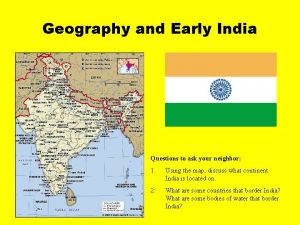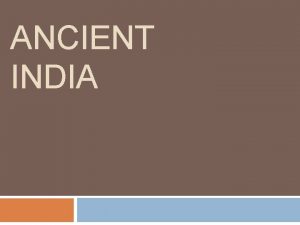Geography and Early India Questions to ask your








- Slides: 8

Geography and Early India Questions to ask your neighbor: 1. Using the map, discuss what continent India is located on. 2. What are some countries that border India? What are some bodies of water that border India?

India is a peninsula. India is MASSIVE! • India is a subcontinent. • A subcontinent is a large landmass that is smaller than a continent. • Usually, subcontinents are separate from continents by physical features like mountains or rivers. • India is separated from Asia by the Himalayas to the north and the Kush to the west. The Himalayas are the highest mountains in the world. The most important river to flow from the Himalayas is the Indus River.

The Indus River What other civilizations have relied on rivers to survive? Were floods always a good thing for farmers? Why? • The Indus River is located in present day Pakistan. • When heavy snow in the Himalayas caused by monsoons melted, the Indus flooded. • It was the silt from this flood water that made agriculture possible in India. Monsoons are seasonal wind patterns that cause wet and dry seasons.

Harappan Civilization MOHENJO DARO • The civilization that grew in the Indus River Valley was called the Harappan Civilization. • The civilization survived because of irrigation, surpluses, and improved agriculture. • Two major cities in the Harappan Civilization were Harappa and Mohenjo Daro. City streets were paved with brick and lined with stores, workshops, markets, and houses. The people who lived in these cities enjoyed indoor plumbing. H A R A P P A

Harappan Achievements • • • Harappans developed a system of weights and measures. They made excellent pottery, jewelry, ivory objects, and were the first to make cotton clothing. Harappans developed India’s first writing system that scholars have yet to crack. Harappans are believed to have had kings and a strong central government, but the truth is unknown because we can’t read their writing. Compare and contrast the amount of information we know about Egyptians with how much we know about Harappa and its people.

What do you think caused Harappan society to collapse? Aryan Invasion • The Harappan civilization collapsed in the early 1700 s BC, but nobody is sure why. • A new people, the Aryans, took over. • The Aryans were very skilled warriors who fought with advanced weapons and chariots. • Much of what we know about the Aryans comes from a collection of writings called the Vedas. While most of the Vedas were about religion, some of them were about battles fought in India. The Vedas are collections of poems, myths, and rituals written by priests.

Aryan Government and Society Raja Herders Farmers • Originally, Aryans were nomads, moving along with herds of animals. • Aryans then began to form small communities where they learned to farm. • Each community had its own leader, or raja, who was usually a powerful warrior. • Rajas sometimes became allies but often times fought one another. How do Harrapan and Egyptian societies differ?

What source provides much of the information we know about the Aryans? Aryan Language • The most important language of ancient India was Sanskrit. • Sanskrit made it possible for us to study India’s past as we have today. • The language is no longer spoken but is the root of many South Asian languages. Come up with a sentence that explains the importance of language in the study of ancient cultures.
 What is your favourite
What is your favourite Ask tell ask feedback model
Ask tell ask feedback model If your instructor were to ask if you cleaned up your room
If your instructor were to ask if you cleaned up your room Questions to ask your family
Questions to ask your family Cousin kate summary
Cousin kate summary Early cpr and early defibrillation can: *
Early cpr and early defibrillation can: * Look at the photos and answer the questions
Look at the photos and answer the questions How do psychologists ask and answer questions?
How do psychologists ask and answer questions? Look at the picture and answer
Look at the picture and answer















